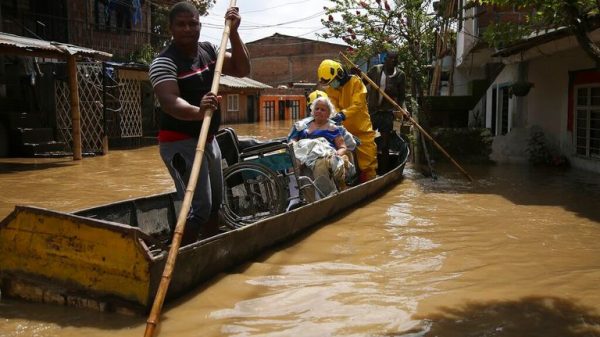The father of an Australian teenager who died from methanol poisoning while on a backpacking holiday has issued a plea to the Laos government to fully investigate his daughter’s death and ensure such incidents don’t happen again.
Bianca Jones, 19, was one of six foreign tourists who died in a suspected mass methanol poisoning in Vang Vieng, a popular backpacker destination in northern Laos.
The deaths of two Australian teenagers, a British woman, an American man and two Danish women – and reports of others taken ill – prompted several Western nations to warn their citizens of the potentially fatal consequences of drinking tainted alcohol in the Southeast Asian country.
Laos, an opaque communist state that tightly controls its media, remained silent on the deaths for over a week before issuing its first statement, but details are still scant, including who else remains in hospital, which nationalities are affected and how widespread the poisonings are.
“We can’t have the passing of our daughter … not lead to change to protect others,” he said.
Bianca Jones was enjoying a backpacking trip to Laos with her friend when they became severely ill after a night out in Vang Vieng. The two friends were ultimately transferred to separate hospitals in neighboring Thailand where they spent several days fighting for their lives in critical condition.
Bianca Jones’ death was announced on Thursday, her friend Holly Bowles died the following day.
“Our daughter was on the trip of a lifetime with one of her best mates,” Jones said, according to Nine News. “This was meant to be a trip full of lifelong memories, and was to be the first of many.”
“Young men and women should be able to travel, create their own life experiences and be safe,” he added. “We’ll forever miss our beautiful girl and hope her loss of life has not been in vain.”
British national Simone White, a 28-year-old lawyer, was also among those who died in Laos.
In the wake of their daughters’ deaths, Bianca Jones and Holly Bowles’ parents have set up a GoFundMe page to help raise awareness of methanol poisoning, describing it “a silent but deadly risk that often claims lives without warning.”
The fundraiser, which has already received more than $133,000, aims to assist the families with expenses in bringing their loved ones’ home, support prevention efforts and launch awareness campaigns to educate travelers, communities and businesses about the dangers of methanol poisoning.
Methanol is an alcohol chemical commonly used in industrial solvents, cleaning products and fuel, though it can be added to alcoholic drinks either inadvertently through traditional brewing methods or deliberately – usually in the pursuit of profit.
Though the complete circumstances of those deaths remains unclear, a statement from the official Lao News Agency (KPL) Friday reported the “suspected cause of the death is believed to be the consumption of tainted alcoholic beverages.”
But Laos authorities have not given any indication of where and how tainted alcohol might have been served.
On Saturday, Laos state media The Vientiane Times identified three others who died as Danish nationals Anne-Sofie Orkild Coyman, 20, Frela Vennervald Sorensen, 21, and US citizen James Louis Hutson, 57.
In an official statement, the Laos government said investigations were underway to find out the cause of the deaths and vowed to “bring the perpetrators to justice.”
The government “is profoundly saddened over the loss of lives of foreign tourists in Vang Vieng District … and expresses its sincere sympathy and deepest condolences to the families of the deceased,” it said in a short statement.
Citing a Laos Police Immigration Department report, The Vientiane Times said Laos authorities are “also aware of Australian media reports, which suggest that 12 other foreign tourists have been hospitalized.”
At least five of the six tourists who died stayed at the same hostel in Vang Vieng, and part of the investigation has focused on reports the hostel had offered guests free shots of alcohol before they left for a night out.
The hostel’s owner and manager have been detained but not charged, the Associated Press reported, citing an officer at Vang Vieng’s Tourism Police office and hostel staff.
Backpacker town at the center of the suspected mass poisoning
Thousands of people suffer from methanol poisoning every year, with most cases reported in Asia from people drinking bootlegged liquor or homemade alcohol. Many Southeast Asian nations have low safety standards, patchy regulatory enforcement and high levels of police corruption.
Colin Ahearn, owner of the Facebook page “Just Don’t Drink Spirits in Bali,” which raises awareness about methanol poisoning in the region, said “this has been by far the biggest case I’ve ever come across.”
“It’s an underground, criminal-type thing when you get this number of cases in one particular area,” he said, and was “a way to lower costs of doing business.”
Laos, one of the poorest countries in Southeast Asia, has been hit hard by skyrocketing inflation in recent years. Tourism is a key source of revenue for the country’s struggling economy.
A major part of that much-needed revenue comes from towns like Vang Vieng. It has long attracted crowds of foreign tourists as an idyllic stopping point between the capital Vientiane and UNESCO World Heritage-listed city of Luang Prabang.
In the early- to mid-2000s, the picturesque rural town gained a notorious reputation on the Southeast Asian “banana pancake” trail for its wild parties and river tubing culture, along with the wide availability of cheap alcohol and illicit drugs.
A string of fatal accidents linked to poor safety standards and a culture of excess along the river prompted the government in 2012 to shut several bars and activities, reinventing the town as an eco-paradise and adventure travel hub.
Backpackers are not the only group drawn to Laos and Vang Vieng’s mountainous surroundings. In recent years, the town has become popular with a broader range of tourists, especially among families and tour groups from South Korea and neighboring China.
Laos has also become a major focus of China’s vision for Southeast Asia as part of its Belt and Road Initiative (BRI), a vast overseas infrastructure development program that launched more than a decade ago.
A $5.5 billion railway has brought a flood of Chinese investment to the remote, landlocked country. In 2021, the semi-high-speed Laos-China Railway opened to passengers, connecting the southwestern Chinese commercial hub of Kunming to the Laos capital – a roughly 10-hour journey spanning some 1,000 kilometers (621 miles).
Officials claim it has boosted numbers of overland Chinese travelers while greatly benefiting local vendors and businesses, though the project is seen by some analysts as a “fiscal trap.”
And this year, a “Laos Year 2024” initiative was launched with a goal of bringing in 4.6 million tourists and generating $712 million.



























